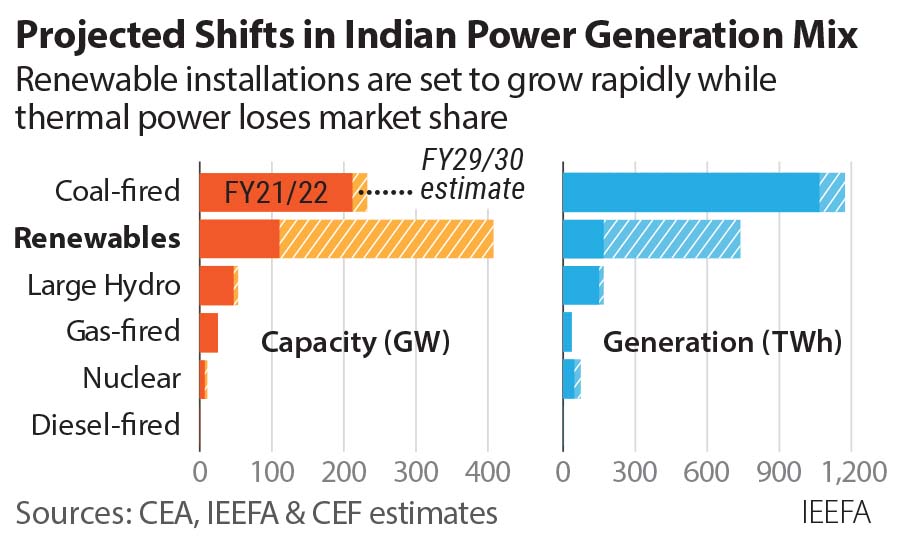India projected to add 35-40GW of renewable energy capacity annually to FY2029/30

Ambitious government targets and commitments by both private and state-owned companies will propel renewable energy installations
Key Takeaways:
Even though there is some renewed momentum building for expanding use of domestic thermal energy in India, the long-term trajectory for renewable energy remains intact.
India is projected to surpass its 2030 target of 50% generation from non-fossil fuel sources supported by renewable energy commitments from industry players and various potential demand- and supply-side triggers.
The biggest global utilities also have ambitious clean energy and decarbonisation goals supported by policy, global finance and technological tailwinds.
13 October (IEEFA India & CEF): India’s renewable energy installations are projected to grow rapidly with 35-40 gigawatts (GW) added annually through to the fiscal year (FY) 2029/30, according to a new report by the Institute for Energy Economics and Financial Analysis (IEEFA) and Climate Energy Finance (CEF).
IEEFA and CEF estimate that renewable energy capacity will reach 405GW in FY2039/30, putting India on track to surpass its target of 50% of its energy from non-fossil fuel sources by 2030.
Thermal power, on the other hand, is set to progressively lose market share, with the expanding use of domestically produced thermal energy in response to recent global events likely to be a “short-term hiccup”, the report says.
Competition from renewable energy, hyperinflation in fossil fuel commodity prices and increased global capital pledges under the US$130 trillion Glasgow Finance Alliance for Net Zero (GFANZ) to align investments with a 1.5°C limit to global warming will reduce thermal power’s share of generation to just 53.4% in FY2029/30 from 72.3% in FY2021/22, according to the report.
“India has been one of the champions globally in adopting renewable energy as part of its energy transition. While recent headwinds faced by the renewable energy sector and rapidly rising power demand has forced the government to re-look at thermal power as a short-term fix, the government’s clean energy capacity addition targets as well as commitments by various corporations remain ambitious,” says the report’s co-author Vibhuti Garg, Director, South Asia, IEEFA.
In the utility-scale segment, the combined additional capacity targets through to 2030 by some of the top players operating in the industry stand at ~231GW. This includes commitments by state-owned NTPC at 60GW, Adani Green Energy at 45GW and Tata Power, ReNew Power and Acme Solar at 25GW each.
“The Indian government seems unbending in ensuring the renewable energy targets are met through facilitating growth across the sector’s spectrum. Financially strong investors, such as the Indian government, domestic conglomerates and some of the biggest global investors, back most industry players, lending them the firepower needed to fulfil their capacity addition targets,” says Garg.
Looking beyond utility-scale capacity additions, the report identifies three areas – rooftop solar, solar pumps and renewable energy capacity addition by non-power public sector companies – that will supplement power generation from non-fossil fuel sources.
“On the decentralised renewable energy side, several segments have the potential to grow multifold as policy-side reforms streamline current bottlenecks and demand-side drivers provide lucrative returns,” says co-author Shantanu Shrivastava, Energy Finance Analyst, IEEFA.
“On the demand side, green hydrogen is a major force that promises to massively drive India’s clean energy ambitions. Corporates, such as the Adani Group and Reliance Industries, have wholeheartedly supported the country’s green hydrogen policy, announced in June 2022, and its 5 million tonnes per annum (MTPA) target, with several major commitments.”
The report finds that India’s green hydrogen target of 5 MTPA by 2030 will require additional renewable energy capacity of ~118GW.
To put the ambitions of Indian corporates into context, the report also undertakes a study of similar clean energy commitments by four global majors – NextEra Energy (U.S.), RWE (Germany), Ørsted (Denmark) and Enel (Italy).
“Understanding the clean energy commitments of domestic players compared with global counterparts also provides perspective on where India’s renewable energy plans stand relative to international developments and what Indian utility players can leverage from the experience of global leaders,” says co-author Tim Buckley, Director, CEF.
“We find that the ambitious decarbonisation targets of the four global companies, which do not rely on carbon offsets or carbon capture and storage, have helped their share prices outperform broader equity markets. It has also helped the companies tap a rapidly growing global green bond market.”
The report also finds that all four companies – NextEra Energy, RWE, Ørsted and Enel – have accelerated world-leading investment plans in response to the hyperinflation of fossil fuel commodity prices, reflective of the increasing cost competitiveness of firmed renewable energy.
Further, the report finds that across all the jurisdictions where they operate, a recurrent theme has been accelerating action to progressively reduce fossil fuel-based asset reliance and doubling down efforts in supporting the clean energy sector.
Read the report: India’s Renewable Energy Journey: Short-Term Hiccups but Long-Term Trajectory Intact
Media contacts: Rosamond Hutt ([email protected]) Ph: +61 406 676 318. Annemarie Jonson ([email protected]) Ph: +61 428 278 880.
Author contacts: Vibhuti Garg ([email protected]); Tim Buckley ([email protected])
About IEEFA: The Institute for Energy Economics and Financial Analysis (IEEFA) examines issues related to energy markets, trends, and policies. The Institute’s mission is to accelerate the transition to a diverse, sustainable and profitable energy economy. (ieefa.org)
About CEF: Climate Energy Finance (CEF) conducts public interest research and analyses on global financial and economic issues related to the global energy transition, as well as the implications for the Australian economy, with a key focus on the threats and opportunities for Australian investments and exports. (climateenergyfinance.org)













